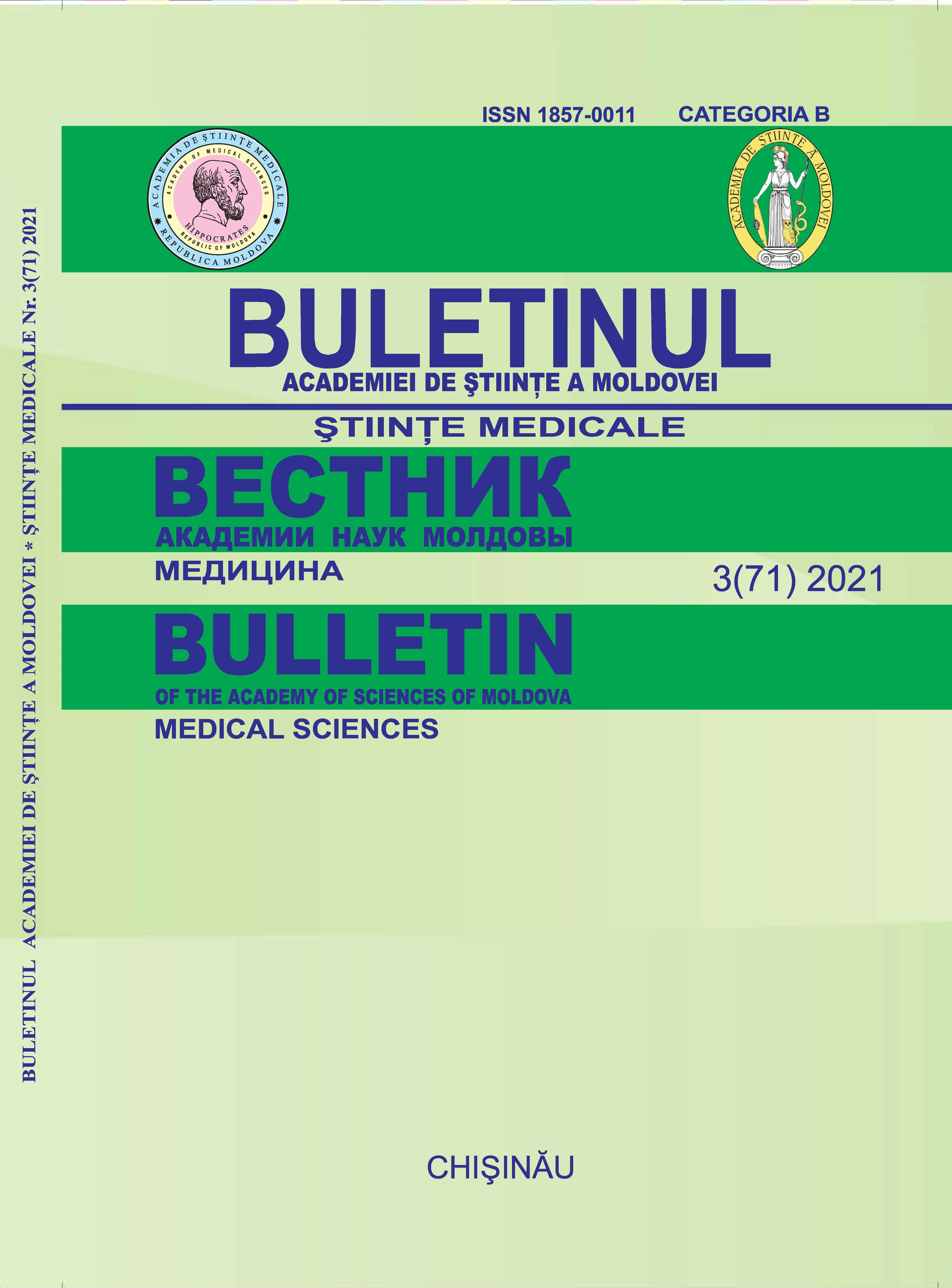Gliomas masks: a series of cases
DOI:
https://doi.org/10.52692/1857-0011.2021.3-71.04Keywords:
gliomas, autopsy, stroke, masksAbstract
Gliomas are primary brain tumors originating from glial cells. Cases are described when the first symptoms of a glioma are masked by other pathologies, such as strokes, demyelinating pathologies, encephalitis, or trauma. These are the “masks” of gliomas. The relationship between gliomas and their masks is multilateral and contradictory.
The aim of the research was to analyze cases of divergence from clinical diagnosis to an autopsy when glial tumors were not identified because they were masked by other pathologies.
Material and method: All necropsy records of patients treated in the Institute of Neurology and Neurosurgery from 2017 to 2019 were retrospectively analyzed. 17 cases of divergence were identified and analyzed.
Results: The mean age of the analyzed subjects was 59.1176 ± 14.33 years, they were treated on average 23.8 ± 23.5 days and were hospitalized on average 2.05 ± 1.29 times. Of which 70.6% women and 29.4% men and 41.2% underwent neurosurgery. The clinical picture included cognitive signs (23.5%), headache (41.2%), speech problems (23.5%), bulbar syndrome (35.3%), pain (5.9%), fever (41.2%). History of ischemic stroke - 17.6%. All were scanned but just 41.2% had MRI, only 23.5% suspected tumor. Morpho pathological examination showed that 58.8% were grade IV gliomas and were accompanied by ischemic lesions (11.8%), hemorrhagic (29.8%), and infection (50%) outbreaks.
Conclusion: Retrospective analysis of necropsy results for 2017-2019 demonstrated the presence of a set of patients in whom cerebral gliomas were difficult to identify and were confused with strokes or other diseases. Additional measures are needed to identify atypical cases and to identify masks.
References
Louis DN, Perry A, Reifenberger G, et al. The 2016 World Health Organization Classification of Tumors of the Central Nervous System: a summary. Acta Neuropathol. 2016;131(6):803-20. Epub 2016/05/10.
Villanueva-Meyer JE, Mabray MC, Cha S. Current Clinical Brain Tumor Imaging. Neurosurgery. 2017;81(3):397-415. Epub 2017/05/10.
Ghosh MK, Chakraborty D, Sarkar S, et al. The interrelationship between cerebral ischemic stroke and glioma: a comprehensive study of recent reports. Signal Transduct Target Ther. 2019;4:42. Epub 2019/10/23.
Thust SC, Heiland S, Falini A, et al. Glioma imaging in Europe: A survey of 220 centres and recommendations for best clinical practice. Eur Radiol. 2018;28(8):3306-17. Epub 2018/03/15.
Selvik HA, Thomassen L, Bjerkreim AT, et al. Cancer-Associated Stroke: The Bergen NORSTROKE Study. Cerebrovasc Dis Extra. 2015;5(3):107-13. Epub 2015/12/10.
Lupa JT, Raizer JJ, Helenowski IB, et al. The Impact of Perioperative Arterial Infarct on Recurrence, Functional Outcomes, and Survival in Glioblastoma Patients. Front Oncol. 2020;10:706. Epub 2020/06/02.
Navi BB, Iadecola C. Ischemic stroke in cancer patients: A review of an underappreciated pathology. Ann Neurol. 2018;83(5):873-83. Epub 2018/04/11.
Bang OY, Chung JW, Lee MJ, et al. Cancer-Related Stroke: An Emerging Subtype of Ischemic Stroke with Unique Pathomechanisms. J Stroke. 2020;22(1):1-10. Epub 2020/02/07.
Zoller B, Ji J, Sundquist J, et al. Risk of haemorrhagic and ischaemic stroke in patients with cancer: a nationwide follow-up study from Sweden. Eur J Cancer. 2012;48(12):1875-83. Epub 2012/02/03.
Chen C-W, Feng W, Chung-Han H, et al. Increased risk of brain cancer incidence in stroke patients: a clinical case series, population-based and longitudinal follow-up study. Oncotarget. 2017;8(65):pp: 108989-99.
Adam G, Ferrier M, Patsoura S, et al. Magnetic resonance imaging of arterial stroke mimics: a pictorial review. Insights Imaging. 2018;9(5):815-31. Epub 2018/06/24.
Downloads
Published
Issue
Section
License
Copyright (c) 2022 Bulletin of the Academy of Sciences of Moldova. Medical Sciences

This work is licensed under a Creative Commons Attribution 4.0 International License.



